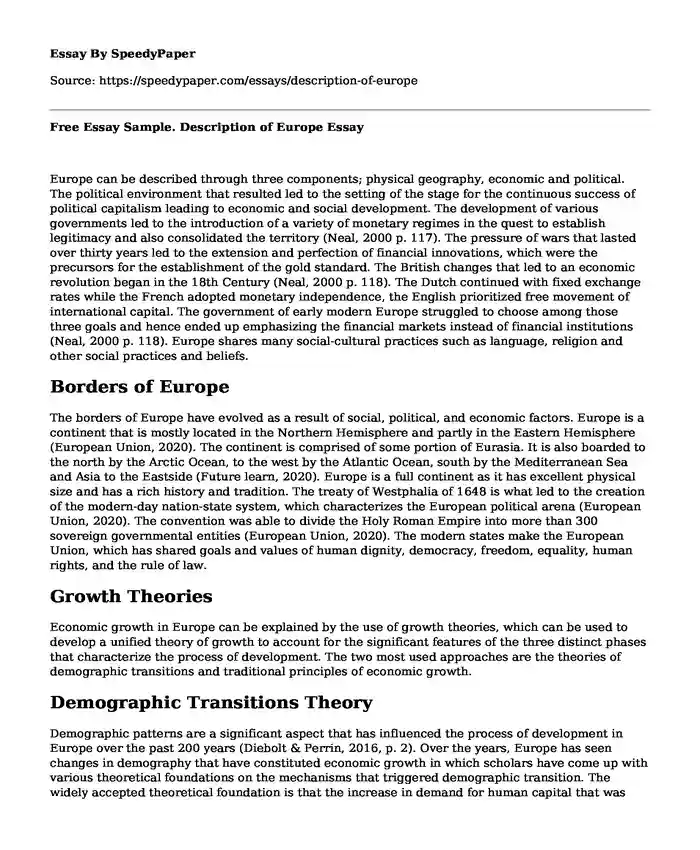Europe can be described through three components; physical geography, economic and political. The political environment that resulted led to the setting of the stage for the continuous success of political capitalism leading to economic and social development. The development of various governments led to the introduction of a variety of monetary regimes in the quest to establish legitimacy and also consolidated the territory (Neal, 2000 p. 117). The pressure of wars that lasted over thirty years led to the extension and perfection of financial innovations, which were the precursors for the establishment of the gold standard. The British changes that led to an economic revolution began in the 18th Century (Neal, 2000 p. 118). The Dutch continued with fixed exchange rates while the French adopted monetary independence, the English prioritized free movement of international capital. The government of early modern Europe struggled to choose among those three goals and hence ended up emphasizing the financial markets instead of financial institutions (Neal, 2000 p. 118). Europe shares many social-cultural practices such as language, religion and other social practices and beliefs.
Borders of Europe
The borders of Europe have evolved as a result of social, political, and economic factors. Europe is a continent that is mostly located in the Northern Hemisphere and partly in the Eastern Hemisphere (European Union, 2020). The continent is comprised of some portion of Eurasia. It is also boarded to the north by the Arctic Ocean, to the west by the Atlantic Ocean, south by the Mediterranean Sea and Asia to the Eastside (Future learn, 2020). Europe is a full continent as it has excellent physical size and has a rich history and tradition. The treaty of Westphalia of 1648 is what led to the creation of the modern-day nation-state system, which characterizes the European political arena (European Union, 2020). The convention was able to divide the Holy Roman Empire into more than 300 sovereign governmental entities (European Union, 2020). The modern states make the European Union, which has shared goals and values of human dignity, democracy, freedom, equality, human rights, and the rule of law.
Growth Theories
Economic growth in Europe can be explained by the use of growth theories, which can be used to develop a unified theory of growth to account for the significant features of the three distinct phases that characterize the process of development. The two most used approaches are the theories of demographic transitions and traditional principles of economic growth.
Demographic Transitions Theory
Demographic patterns are a significant aspect that has influenced the process of development in Europe over the past 200 years (Diebolt & Perrin, 2016, p. 2). Over the years, Europe has seen changes in demography that have constituted economic growth in which scholars have come up with various theoretical foundations on the mechanisms that triggered demographic transition. The widely accepted theoretical foundation is that the increase in demand for human capital that was needed for development was the most significant trigger that led to the decline of fertility hence causing the transition to modern growth (Galor, 2012 p. 15). The acceleration of technological innovation led to a notable growth rate per capita, which led to the generation of increased population growth. The decline of population growth in Europe marked the end of the Post-Malthusian Regime, which saw the transition to the modern extension of the economy (Diebolt & Perrin, 2016, p. 3).
Traditional Theories of Economic Growth
The Malthusian theory postulates that population growth is bounded utilizing subsistence, and the increase in population with a livelihood in a geometric progression with the growth of food production grows in an arithmetic progression as seen in Europe (Diebolt & Perrin, 2016 p. 5). This theory shows that there is an interplay between the rate of population growth, income per capita, technological advances, and the accumulation of physical and human capital. According to the neoclassical theory, the economic growth of Europe was determined by the production of goods, outputs, and income distribution in the marked as guided by demand and supply. The Endogenous growth theory holds that the economic growth of Europe was due to endogenous factors such as technological advancements (Diebolt & Perrin, 2016, p. 6).
Unified Theory of Growth
The Unified Theory of Growth states that during the existence of humanity, technological innovation, and advancements were offset by population growth and living standards, as seen in the economic growth of Europe (Diebolt & Perrin, 2016 p. 8). Europe allocated more resources on technological innovation and education hence leading to a fertility decline. This process led to high income per capita instead of population growth, which saw progress to sustained economic growth.
Bibliography
Diebolt, C., and Perrin, F., 2016. Growth theories. Handbook of clinometric. Springer, Berlin, pp.177-195. Retrieved from: http://cliometrie.org/images/wp/AFC_WP_02-2014.pdf
European Union, 2020. The EU in brief. Europa. Retrieved from: https://europa.eu/european-union/about-eu_enFuture learn, 2020. What are the borders of Europe? Future Learn. Retrieved from: https://www.futurelearn.com/courses/european-culture/0/steps/23472
Galor, O., 2012. The demographic transition: causes and consequences. Clinometric, 6(1), pp.1-28. Retrieved from: https://link.springer.com/article/10.1007/s11698-011-0062-7
Neal, L., 2000. How it all began: the monetary and financial architecture of Europe during the first global capital markets, 1648-1815. Financial History Review, 7(2), pp.117-140. Retrieved from: https://www.cambridge.org/core/journals/financial-history-review/article/how-it-all-began-the-monetary-and-financial-architecture-of-europe-during-the-first-global-capital-markets-16481815/10DC1F44B81D2E6805161AE098F0D4AA
Cite this page
Free Essay Sample. Description of Europe. (2023, Apr 13). Retrieved from https://speedypaper.com/essays/description-of-europe
Request Removal
If you are the original author of this essay and no longer wish to have it published on the SpeedyPaper website, please click below to request its removal:
- Negative Effects of Advertising on Youth, Essay Example
- Personal Essay Example: My First Day in College
- Is Psychology a Science? Free Paper Sample with Annotated Bibliography
- Essay Example: Professional Interview with a Teacher
- Free Essay on How Erhard Lost and Regained Himself
- Essay Sample on Historical Perspective of Logotherapy Theory
- Capitalism Unveiled: Objections, Moral Considerations, and Economic Challenges in Today's Society
Popular categories





